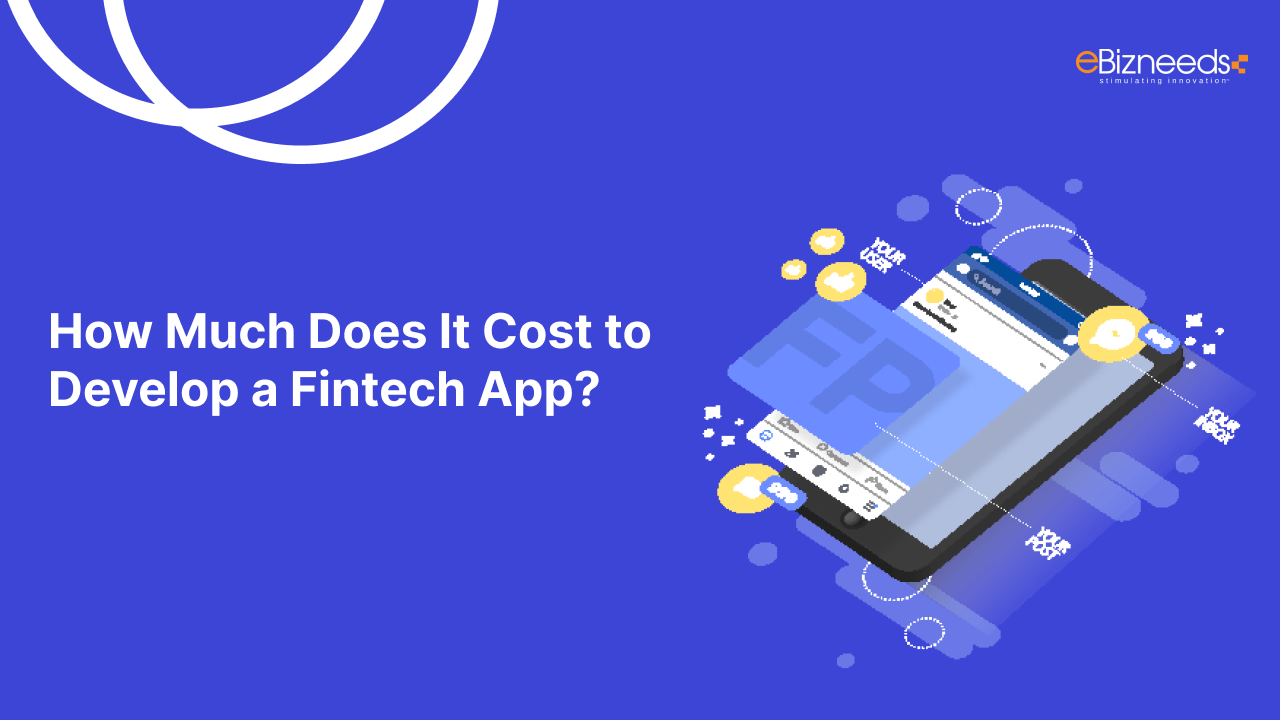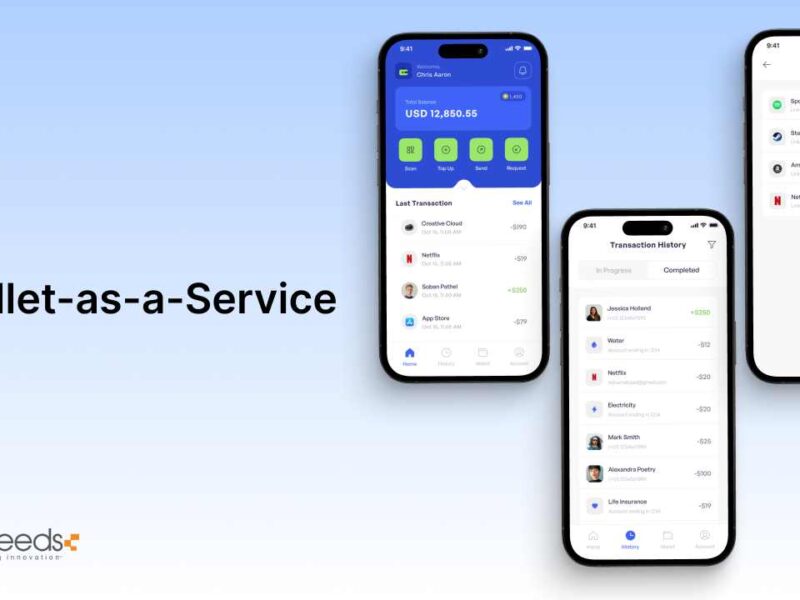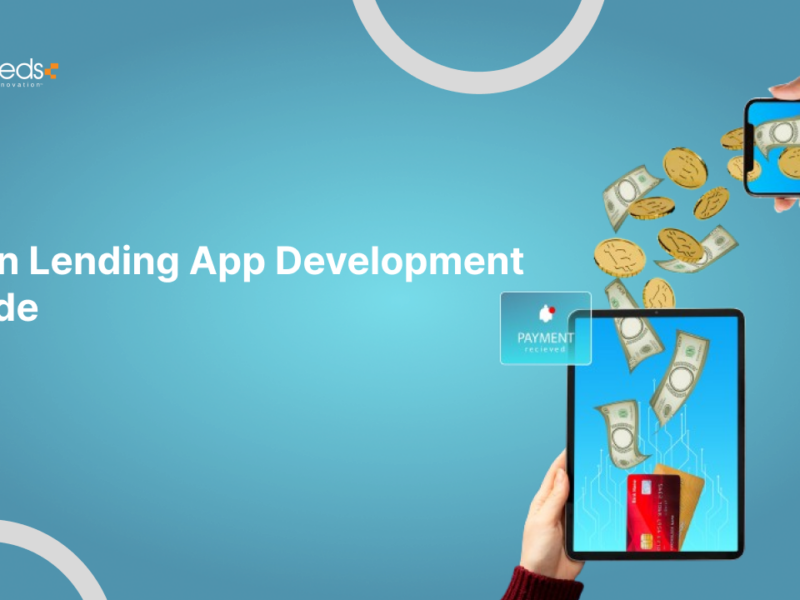When you think about launching a fintech app, one of the first questions that likely comes to mind is
“How much does it cost to develop a fintech app?”
While the final price depends on a variety of factors, the typical range falls between $50,000 and $300,000, depending on the app’s complexity, features, and technology stack.
Building a fintech app involves more than just coding; it’s about creating a seamless, secure, and user-friendly platform that meets strict compliance standards and delights your users.
Whether you’re planning a simple budgeting tool or a full-fledged digital banking app, understanding the costs upfront can help you plan your investment wisely.
This guide will break down every detail you need to know, from the factors influencing development costs to strategies for cost optimization.
By the end, you’ll have a clear picture of what it takes to develop a fintech app that stands out in today’s competitive landscape.
Should You Develop a Fintech App?
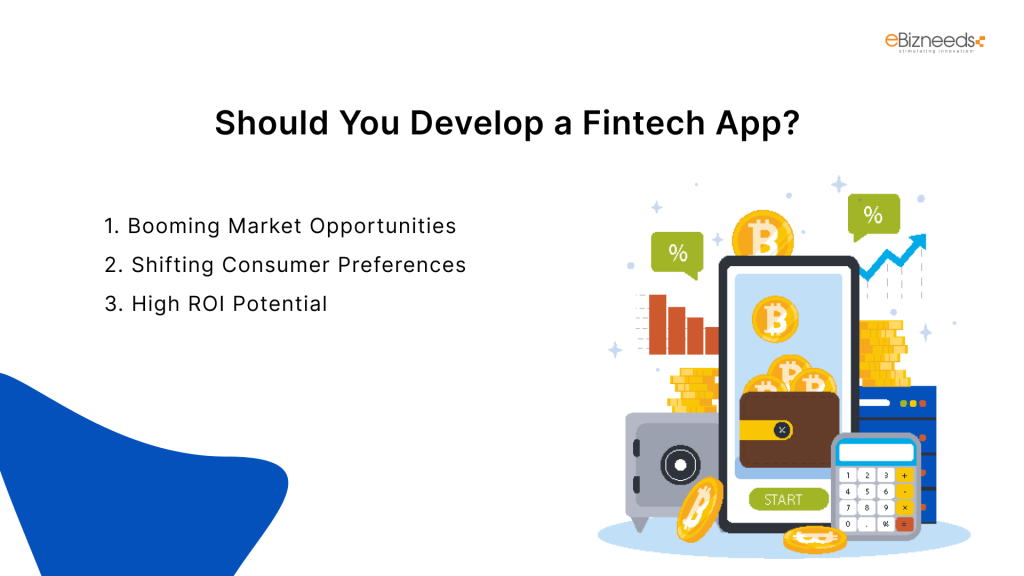


With the fintech industry thriving, the question isn’t “Why develop a fintech app?” but rather “Why wait?”
Here are three compelling reasons why launching a fintech app can be a game-changing decision for your business:
1. Booming Market Opportunities
Fintech apps are at the forefront of the financial industry’s evolution.
According to Statista, the global fintech market is projected to reach a staggering $332.5 billion by 2028, growing at a compound annual growth rate (CAGR) of 19.8%.
This growth reflects a surge in demand for financial services that are secure, fast, and accessible. Developing your app now positions you to capitalize on this momentum.
2. Shifting Consumer Preferences
Modern users expect digital-first solutions for managing their finances.
A report from Deloitte found that 82% of millennials prefer banking digitally over traditional methods.
A fintech app offers the convenience, speed, and innovation that today’s consumers demand, ensuring you meet their expectations and remain competitive.
3. High ROI Potential
The profitability of fintech apps is unmatched.
For example, digital wallet apps like PayPal and Venmo reported transaction revenues of over $10 billion combined in 2023 alone.
With subscription models, transaction fees, and partnerships, fintech apps have multiple monetization avenues to ensure strong returns on investment.
Average Cost to Develop a Fintech App
So, how much does it cost to develop a fintech app?
The short answer: it depends.
On average, fintech app development costs range from $50,000 to $300,000, but this figure varies based on factors such as app complexity, features, and the development team’s location.
Here’s a quick breakdown of typical development cost based on app types:
| Fintech App Type | Estimated Cost Range |
| Basic Fintech App (e.g., Budgeting Tool) | $50,000 – $80,000 |
| Intermediate App (e.g., Digital Wallet) | $80,000 – $150,000 |
| Advanced App (e.g., Digital Banking) | $150,000 – $300,000+ |
While these are averages, your actual cost may fluctuate depending on your specific requirements.



Also known as factors, before we look at the factors, let’s see the different types of fintech apps and associated cost.
Types of Fintech Apps and Development Costs
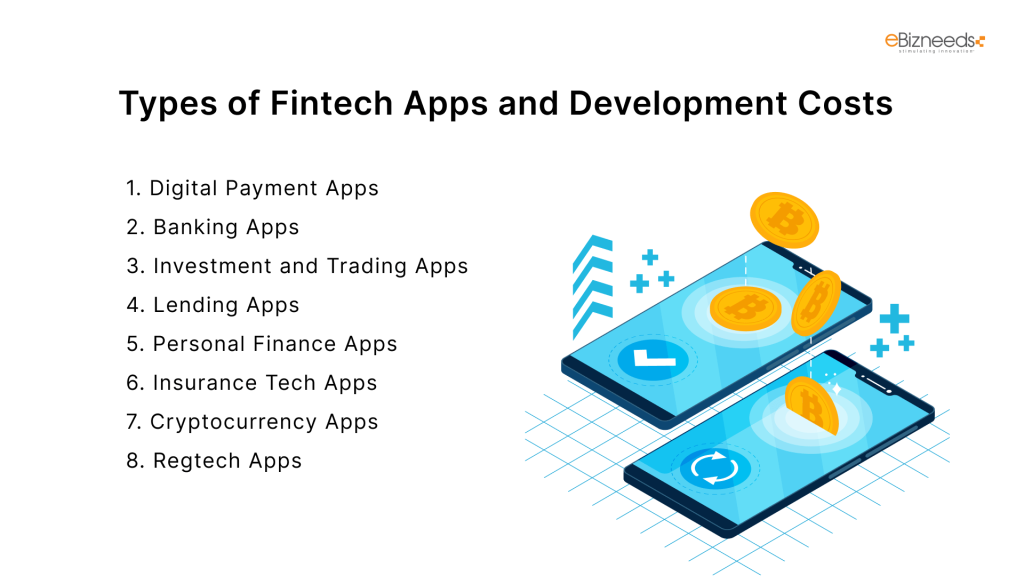


Fintech apps have diversified into various categories, catering to specific financial services.
Each type has unique features and functionalities, which influence its development cost.
Understanding these categories can help you decide the type of app that aligns with your business goals and budget.
1. Digital Payment Apps
There are a lot of people who want to develop digital wallets.
These apps, like PayPal and Venmo, enable peer-to-peer payments, bill payments, and online transactions.
They require robust security and multi-currency support.
| Features | Examples | Development Cost |
| Peer-to-peer payments, QR codes, fraud detection | PayPal, Venmo | $100,000 – $300,000 |
2. Banking Apps
Banking apps offer users the ability to manage accounts, transfer funds, and access banking services directly from their smartphones.
They require compliance with banking regulations and advanced security measures.
Here’s how much it will cost if you want to develop a mobile banking app:
| Features | Examples | Development Cost |
| Account management, real-time notifications | Chime, Wells Fargo Mobile | $150,000 – $400,000 |
3. Investment and Trading Apps
Apps like Robinhood and Acorns allow users to trade stocks, manage portfolios, or invest spare change.
These apps require integrations with market data APIs and advanced analytics.
| Features | Examples | Development Cost |
| Stock trading, portfolio tracking, AI analytics | Robinhood, Acorns | $200,000 – $500,000 |
4. Lending Apps
Developing a loan lending app has become a popular trend.
These apps simplify loan applications, approvals, and repayments. They often use AI to assess creditworthiness and offer personalized loan options.
| Features | Examples | Development Cost |
| Loan management, credit score monitoring | LendingClub, SoFi | $150,000 – $350,000 |
5. Personal Finance Apps
Personal finance apps, like Mint, help users budget, track expenses, and monitor their financial health.
They require user-friendly dashboards and data visualization features.
| Features | Examples | Development Cost |
| Budget tracking, spending insights, bill reminders | Mint, PocketGuard | $100,000 – $200,000 |
6. Insurance Tech Apps
Insurtech apps streamline insurance policy purchases, claims processing, and renewals.
They often include chatbots for customer support and AI for risk assessment.
| Features | Examples | Development Cost |
| Policy comparison, claims tracking, AI-driven support | Lemonade, Policygenius | $150,000 – $300,000 |
7. Cryptocurrency Apps
Cryptocurrency apps enable users to buy, sell, and store digital currencies securely. They require blockchain technology and robust encryption.
| Features | Examples | Development Cost |
| Cryptocurrency trading, wallet integration | Coinbase, Binance | $250,000 – $500,000+ |
8. Regtech Apps
Regulatory technology (Regtech) apps assist financial institutions in managing compliance and reducing risks.
They rely heavily on AI and data analysis for real-time monitoring.
| Features | Examples | Development Cost |
| Compliance monitoring, fraud prevention | Trulioo, ComplyAdvantage | $200,000 – $400,000 |
Now that you understand the types of fintech apps and their costs,ready to dive into the detailed factors affecting fintech app development costs?
Let’s explore them next.
Factors That Affect Fintech App Development Cost
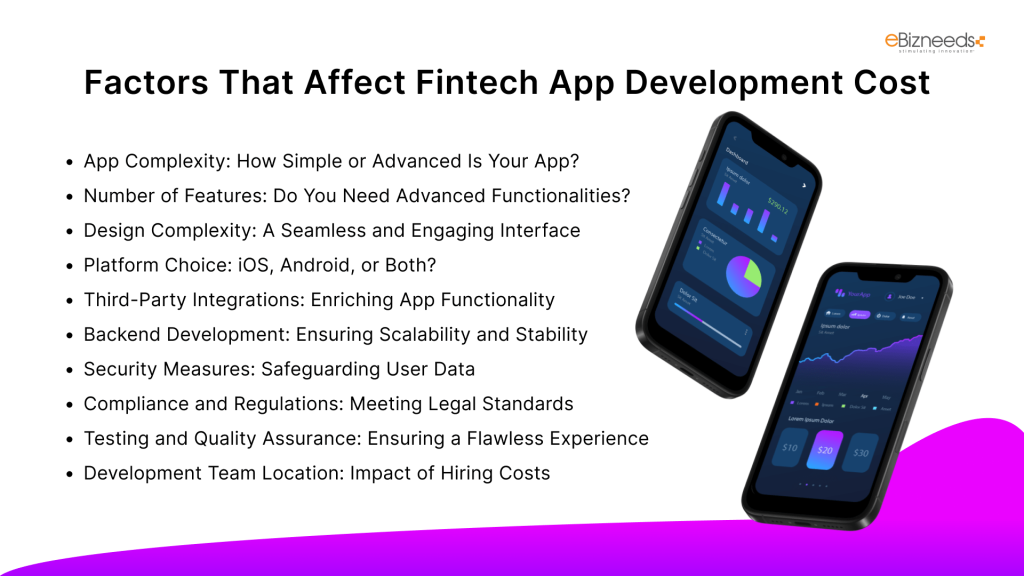


When determining the cost to develop a fintech app, several key factors significantly influence the overall budget.
Let’s explore these elements in detail, with examples and cost breakdowns to give you a clearer picture.
Incorporating these considerations into your planning will help you estimate the resources required for building a fintech app.
1. App Complexity: How Simple or Advanced Is Your App?
The complexity of your app dictates how much time and expertise are required for its development.
A simple fintech app, such as a basic budgeting tool, may only need fundamental features and a straightforward interface.
On the other hand, advanced apps, like digital banking platforms or blockchain-powered payment systems, involve intricate features, customizations, and integrations, driving up costs.
| Complexity Level | Estimated Cost | Development Hours |
| Simple | $50,000 – $80,000 | 500 – 800 hours |
| Intermediate | $80,000 – $150,000 | 800 – 1,500 hours |
| Advanced | $150,000 – $300,000+ | 1,500+ hours |
For businesses wondering how much it costs to build a fintech app, the complexity level is the first and most crucial determinant.
Apps that require cutting-edge features will naturally cost more but can offer a competitive edge in the fintech market.
2. Number of Features: Do You Need Advanced Functionalities?
The features you choose to include in your app can significantly impact the overall cost to make a fintech app.
Basic features like user registration, payment processing, and account management are essential, while advanced functionalities like AI-powered analytics, blockchain integration, and fraud detection add to the development complexity.
| Feature Category | Examples | Additional Cost |
| Basic | User Login, Payments | $10,000 – $20,000 |
| Intermediate | KYC Verification, Chatbots | $20,000 – $50,000 |
| Advanced | Blockchain, AI Analytics | $50,000+ |
If you’re looking to develop a fintech app with state-of-the-art features, be prepared to invest more.
However, these features can significantly enhance user experience and engagement, making your app a market leader.
3. Design Complexity: A Seamless and Engaging Interface
Design plays a pivotal role in determining the cost to build a fintech app.
A simple, minimalistic design may suffice for a budgeting app, but custom and interactive designs with animations, dynamic graphs, and personalized dashboards elevate user experience, particularly for apps targeting high-net-worth individuals.
| Design Type | Cost Range |
| Basic | $5,000 – $10,000 |
| Custom & Interactive | $15,000 – $30,000 |
When creating a fintech app, investing in a user-friendly and intuitive design ensures users stay engaged and find the app easy to navigate.
It’s worth noting that apps with custom designs tend to perform better in terms of user retention.
4. Platform Choice: iOS, Android, or Both?
Deciding whether to build your fintech app for iOS, Android, or both platforms is another factor affecting overall costs.
A single-platform app is cheaper to develop but may limit your audience reach.
Cross-platform apps, while costlier, provide a broader market presence.
| Platform Choice | Estimated Cost |
| Single Platform | $50,000 – $100,000 |
| Cross-Platform | $100,000 – $200,000 |
If your target audience uses a mix of operating systems, a cross-platform approach ensures your app is accessible to everyone, maximizing its adoption and revenue potential.
5. Third-Party Integrations: Enriching App Functionality
Integrating third-party tools and APIs is essential for features like payment gateways, analytics, and fraud detection.
These integrations enhance the app’s functionality but also add to its cost.
| Integration Type | Examples | Cost Range |
| Basic APIs | Payment Gateway | $5,000 – $10,000 |
| Advanced APIs | Fraud Detection | $15,000+ |
For those asking, “How much does it cost to make a fintech app with advanced integrations?” the answer depends on the number and type of APIs you choose.
These integrations improve app performance and provide users with valuable insights.
6. Backend Development: Ensuring Scalability and Stability
The backend is the backbone of any fintech app.
A simple backend may suffice for a personal finance app, but scalable architectures are essential for apps handling high volumes of transactions and user data.
| Backend Type | Cost Range |
| Basic | $10,000 – $30,000 |
| Scalable Architecture | $50,000+ |
A robust backend ensures that your fintech app can handle growth without compromising on performance, a critical factor for apps targeting large user bases.
7. Security Measures: Safeguarding User Data
Given the sensitive nature of financial data, security is paramount.
Implementing basic security measures is a must, but advanced features like AI-driven fraud detection and encryption layers can increase costs.
| Security Feature | Examples | Cost Range |
| Basic | Encryption, Firewalls | $10,000 – $20,000 |
| Advanced | AI Fraud Detection | $20,000+ |
Investing in top-notch security not only protects user data but also enhances your app’s credibility and trustworthiness.
8. Compliance and Regulations: Meeting Legal Standards
Compliance with global financial regulations such as GDPR and PCI-DSS is essential for fintech apps.
These measures ensure that your app adheres to legal standards, but they also contribute to the overall development cost.
| Compliance Area | Cost Range |
| Basic Compliance | $5,000 – $10,000 |
| Advanced Compliance | $20,000+ |
Adhering to compliance requirements protects your app from legal issues and ensures its longevity in the market.
9. Testing and Quality Assurance: Ensuring a Flawless Experience
Rigorous testing and QA processes are vital to delivering a smooth and bug-free app.
Skimping on this step can lead to costly issues post-launch.
| Testing Type | Cost Range |
| Basic Testing | $5,000 – $10,000 |
| Comprehensive QA | $20,000+ |
A fintech app must perform flawlessly under high traffic and sensitive transactions.
Investing in comprehensive testing saves time and money in the long run.
10. Development Team Location: Impact of Hiring Costs
The cost to develop a fintech app varies significantly depending on where your development team is located.
Teams in North America charge premium rates, while those in Asia offer cost-effective solutions.
| Region | Hourly Rate |
| North America | $100 – $200/hour |
| Eastern Europe | $40 – $80/hour |
| Asia | $20 – $50/hour |
Choosing a team based on your budget and quality expectations is critical.
Offshore development can offer significant savings without compromising quality.



These factors collectively determine the cost to create a fintech app tailored to your business goals.
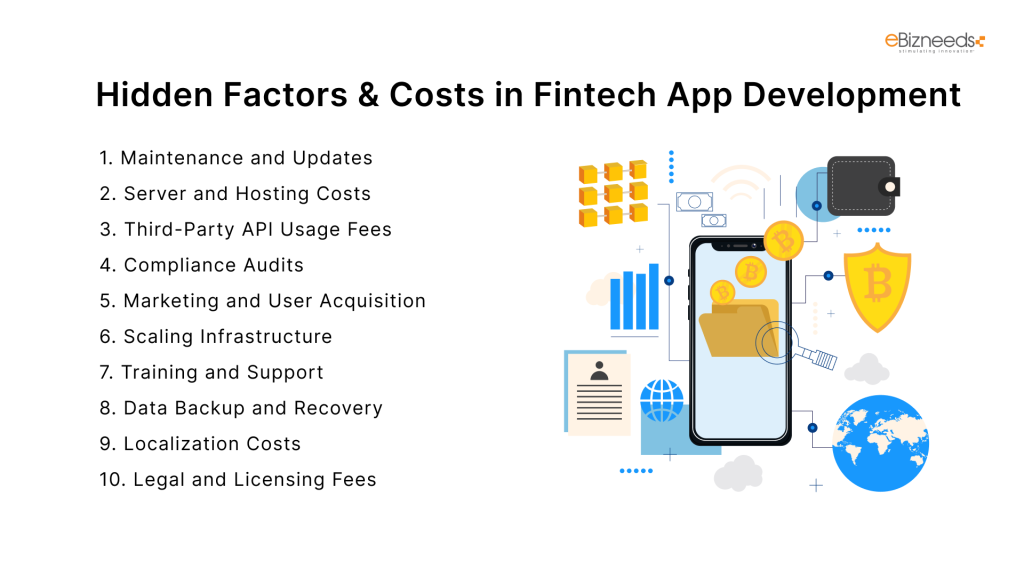


While the obvious factors like features and design significantly influence the cost to develop a fintech app, there are hidden costs that can catch you off guard if not accounted for.
Let’s uncover these hidden factors and break down their potential impact on your budget.
1. Maintenance and Updates
Developing a fintech app is not a one-time investment.
Regular updates, bug fixes, and feature enhancements are necessary to keep your app relevant and functional.
Maintenance typically costs 15-20% of the initial development cost annually.
| Maintenance Activity | Cost Estimate |
| Bug Fixes and Patches | $5,000 – $10,000/year |
| Feature Updates | $10,000+ annually |
| Server Maintenance | $5,000 – $15,000/year |
Neglecting maintenance can lead to poor user experience and loss of credibility. Budgeting for these costs ensures your app remains competitive.
2. Server and Hosting Costs
Fintech apps handle sensitive financial data and often require high-performance servers for seamless operations.
The cost of hosting and server infrastructure depends on the app’s traffic and storage needs.
| Server Type | Cost Estimate (Annually) |
| Basic Hosting | $3,000 – $5,000 |
| Cloud-Based Hosting (AWS, Azure) | $10,000 – $50,000+ |
Opting for scalable cloud solutions ensures reliability during traffic spikes but adds to your recurring expenses.
3. Third-Party API Usage Fees
Many fintech apps rely on third-party services for features like payment processing, identity verification, or market data access.
These services often come with monthly or per-transaction fees.
| API Service | Cost Estimate |
| Payment Gateway (e.g., Stripe) | $0.30 per transaction + 2.9% of the amount |
| KYC Verification | $1 – $5 per user |
| Market Data API | $1,000 – $10,000/year |
The cost of using these APIs scales with your app’s user base and transaction volume, making it a significant ongoing expense.
4. Compliance Audits
To ensure your app remains compliant with regulations such as GDPR or PCI-DSS, periodic audits are essential.
These audits assess your app’s security, data handling practices, and adherence to standards.
| Audit Type | Cost Estimate |
| Annual Compliance Audit | $5,000 – $10,000 |
| Security Penetration Testing | $10,000+ |
Failing to conduct these audits can lead to hefty fines, making them a critical hidden cost.
5. Marketing and User Acquisition
Launching your fintech app without a marketing plan is like building a bridge to nowhere.
You’ll need a budget for user acquisition, which can vary based on your target market and channels.
| Marketing Channel | Cost Estimate (Monthly) |
| Social Media Ads | $2,000 – $10,000+ |
| Influencer Marketing | $5,000+ per campaign |
| SEO and Content Marketing | $1,000 – $5,000 |
A solid marketing strategy ensures your app gains visibility and attracts users, but it’s an expense that many first-time app developers overlook.
6. Scaling Infrastructure
As your user base grows, your app will require additional resources to handle increased traffic.
Scaling infrastructure is often an unforeseen cost for growing fintech apps.
| Scaling Need | Cost Estimate |
| Adding Server Capacity | $5,000 – $20,000+ |
| Enhanced Database Storage | $3,000 – $10,000+ |
Planning for scalability early in development helps you avoid service interruptions and maintain a seamless user experience.
7. Training and Support
If your fintech app serves businesses or enterprise clients, you may need to provide training materials or customer support.
| Support Type | Cost Estimate |
| Customer Support Team | $30,000+ annually |
| Training Materials | $5,000 – $10,000 |
These hidden costs can quickly add up but are essential for maintaining customer satisfaction and retention.
8. Data Backup and Recovery
To ensure the safety of your users’ sensitive financial data, investing in robust backup and recovery systems is non-negotiable.
| Backup System | Cost Estimate |
| Basic Backup Solution | $2,000 – $5,000/year |
| Advanced Recovery Plan | $10,000 – $20,000/year |
These measures protect your app from data loss caused by cyberattacks or system failures.
9. Localization Costs
If you’re targeting a global audience, adapting your app to different languages, currencies, and compliance standards adds to development costs.
| Localization Aspect | Cost Estimate |
| Multi-Language Support | $5,000+ |
| Currency Adaptations | $3,000 – $10,000 |
Localization ensures your app appeals to diverse audiences, increasing its market potential.
10. Legal and Licensing Fees
From acquiring necessary licenses to drafting user agreements, legal fees are another hidden cost in fintech app development.
| Legal Requirement | Cost Estimate |
| Licensing Fees | $1,000 – $10,000+ |
| Legal Consultation | $5,000+ |
Allocating funds for legal compliance prevents potential disputes and protects your business.
By accounting for these hidden costs, you can create a realistic budget for developing your fintech app.
Next, we’ll explore the cost of cloning popular fintech apps and what it takes to replicate their success.
Here’s How to Minimize Development Costs
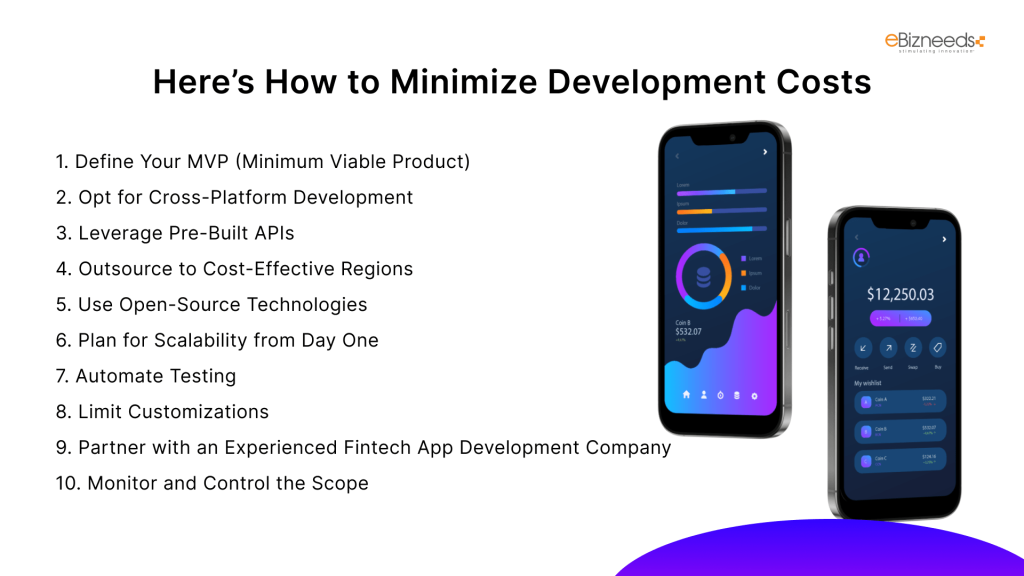


Developing a fintech app doesn’t have to break the bank.
Strategic planning and cost-saving measures can help you optimize expenses while ensuring a high-quality product.
Here are some effective ways to reduce the cost to build a fintech app:
1. Define Your MVP (Minimum Viable Product)
Start with an MVP that includes only the essential features required to address your target audience’s needs.
This approach minimizes initial costs and allows you to test the market before investing in advanced functionalities.
Cost to build an MVP is much lower.
Cost Savings: Up to 30% of the total development cost.
2. Opt for Cross-Platform Development
Instead of building separate apps for iOS and Android, consider cross-platform development frameworks like Flutter or React Native.
This reduces development time and costs while maintaining a native-like experience.
Cost Savings: Up to 40% compared to developing two separate apps.
3. Leverage Pre-Built APIs
Instead of building everything from scratch, use pre-built APIs for features like payment processing, KYC verification, or fraud detection.
These integrations save time and reduce the complexity of development.
Cost Savings: $10,000 – $50,000 depending on the number of APIs used.
4. Outsource to Cost-Effective Regions
Hiring a development team in regions like Eastern Europe or Asia can significantly lower costs without compromising on quality.
Ensure the team has proven experience in fintech app development.
| Region | Average Hourly Rate |
| North America | $100 – $200/hour |
| Eastern Europe | $40 – $80/hour |
| Asia | $20 – $50/hour |
Cost Savings: Up to 50% compared to hiring local developers in North America.
5. Use Open-Source Technologies
Utilize open-source libraries and frameworks to cut down on licensing fees.
Many open-source tools are secure, reliable, and suitable for fintech app development.
Cost Savings: Up to 15% on development costs.
6. Plan for Scalability from Day One
Investing in scalable architecture during the initial development phase can prevent costly overhauls in the future.
This approach ensures that your app can handle growth without requiring extensive rework.
Cost Savings: Saves $10,000+ in potential redevelopment costs.
7. Automate Testing
Automated testing tools like Selenium or Appium can reduce the time and cost associated with manual quality assurance processes, ensuring faster and more efficient testing cycles.
Cost Savings: Up to 20% on QA costs.
8. Limit Customizations
While a unique app design and custom features can make your app stand out, these elements also drive up costs.
Focus on functionality over aesthetics initially and introduce customizations gradually.
Cost Savings: $5,000 – $20,000 depending on the level of customization.
9. Partner with an Experienced Fintech App Development Company
Working with a seasoned development team like eBizneeds ensures efficient project management, timely delivery, and high-quality output.
Their expertise in the fintech industry helps streamline the development process, avoiding unnecessary costs.
Cost Savings: Time and resources spent on revisions and rework.
10. Monitor and Control the Scope
Avoid scope creep by clearly defining your project requirements and sticking to them.
Regular communication with the development team ensures that the project stays on track and within budget.
Cost Savings: Prevents unexpected expenses that could inflate the budget.
eBizneeds – Here to Help You
Looking for a reliable partner to turn your fintech app idea into reality?
eBizneeds is a trusted fintech app development company with years of experience delivering innovative and scalable solutions to businesses worldwide.
Here’s why we’re the perfect choice for your project:
- Expertise in Fintech: We understand the unique challenges of the fintech industry, from regulatory compliance to robust security measures, ensuring your app is both reliable and user-friendly.
- Cost-Effective Solutions: Our strategic development approach minimizes unnecessary expenses while maintaining top-notch quality.
- Customizable Services: Whether you need a basic MVP or a full-featured advanced app, we tailor our services to meet your specific requirements.
- End-to-End Support: From initial consultation to post-launch maintenance, we’re with you at every step of the journey.
- Global Clientele: Our proven track record with clients across industries showcases our ability to deliver excellence, no matter the scale of the project.
Let us help you build a fintech app that not only meets your business objectives but also exceeds user expectations.
Ready to discuss your project? Contact eBizneeds today, your trusted fintech app development company!



Conclusion
Developing a fintech app is an investment that requires careful planning, strategic decision-making, and a trusted development partner.
The cost to develop a fintech app depends on various factors, such as the app’s complexity, features, compliance requirements, and the development team’s expertise.
By understanding these factors and following cost-optimization strategies, you can create a powerful app without exceeding your budget.
Whether you’re building a digital payment app, a trading platform, or a personal finance tool, aligning your app’s features with market needs ensures its success.
FAQs
The cost to develop a fintech app typically ranges from $50,000 to $300,000, depending on the app’s complexity, features, and platform.
Key factors include app complexity, number of features, design, platform choice (iOS, Android, or both), third-party integrations, and compliance with financial regulations.
Yes, strategies like starting with an MVP, using pre-built APIs, opting for cross-platform development, and outsourcing to cost-effective regions can significantly reduce costs.
The development timeline depends on the app’s complexity. A basic app can take 3-6 months, while advanced apps may take 9-12 months or more.
eBizneeds is a trusted fintech app development company with extensive experience, cost-effective solutions, and a client-centric approach, ensuring a seamless development process and high-quality results.



Naveen Khanna is the CEO of eBizneeds, a company renowned for its bespoke web and mobile app development. By delivering high-end modern solutions all over the globe, Naveen takes pleasure in sharing his rich experiences and views on emerging technological trends. He has worked in many domains, from education, entertainment, banking, manufacturing, healthcare, and real estate, sharing rich experience in delivering innovative solutions.
